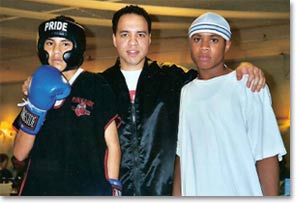Shadow Boxing: 12 Skills to Accelerate Learning!
Shadow boxing begins in the mind. When you shadow box mindlessly it's a waste of time. Focus on and master these 12 skills to accelerate your learning! Many amateur boxers and even professionals simply use shadow boxing as a warm-up before getting into more intense parts of their boxing workout or before their fights. Yes, it's a great way to warm-up your body before hitting the heavy bag or punch mitts, or before sparring or competing in an amateur boxing match, but there is so much more that you can learn and benefit from when shadow boxing.
Advance Your Amateur Boxing Career

Throughout this how to boxing guide I'll share with you how to shadow box to accelerate your boxing skills and better prepare yourself mentally before sparring and/or competing in an amateur boxing match.

These boxing skills will help you rapidly advance in your amateur boxing career, as you start sparring, prepare for your first boxing match, compete in boxing tournaments, and maybe even become a boxing champion!

I'll also included a couple shadow boxing workouts that I use in the gym to train my own beginners, novice and elite amateur boxers, and professional fighters. These workouts that will help you develop your skills while improving your level of boxing conditioning and Boxing IQ. Let's Go Champ!
Learning How to Shadow Box for Acceleration of Skill Development
- Shadow Boxing Basics & Fundamentals
- Footwork & Rhythm Click to get this shadowboxing workout
- Head Movement & Intensity Click to get this shadow boxing workout.
- Defense & Timing
- Counter Punching
- Punching Speed
- Jab and Fient
- Jab-Cross 1-2 punch combination
- Cutting Off the Ring
- Stick and Move
- Punches in Bunches
- Masterful Boxing
Keep Training Like a Champ!
The Art of Shadow Boxing
Before you even walk into the gym or start your own boxing workout at home it's important to set your intention! It starts by answering the question, "What am I going to focus on improving or mastering during my workout?" An intention starts like this " I AM..." then you complete the rest of the sentence.
An example might be "I AM keeping my elbow down as I throw my jab".
Another example might be "I AM keeping my chin down when I throw my punch combinations."
There are many boxing tips that you could decide to focus on depending on your current level of development. The best boxing workouts for beginners will focus on boxing basics, especially when learning how to shadow box. I continue to have all of my boxers (beginners, amateurs, professionals, and even those who come the gym for a boxing fitness workout) participate in drills that reinforce solid fundamentals and make boxing basics become second nature for them. For my competitive amateur and professional boxers they may have a training intention to work on our fight strategy or specific counter punches that they'll be using on an upcoming opponent.
Write your training intention down in a dedicated boxing training journal or log. You will be able to monitor your progress over time and being more mindful or your progress will not only give you a greater sense of fulfillment, but it will ultimately accelerate your growth. This is the true art of shadow boxing and boxing training in general. Your personal growth and daily progress develops habits which ultimately leads to the fulfillment of your goals and desires.
Your intention gives you clear direction and something to measure your development and performance by after your boxing training session is over. It empowers you to monitor your own progress and see your daily growth as a boxer. This is so critical to maintaining high levels of motivation and success throughout your boxing career.
There are so many things you could decide to focus on throughout your workout, but whatever you decide, stick to it from your shadow boxing to hitting the heavy bag, to sparring and competing. Always have a clear intention before you begin your boxing training.
Below I'll explain more "intentions" to focus on and benefit from while shadow boxing other than simply warming up.
Shadow Boxing Basics / Fundamentals
When ever you shadow box or do any other kind of boxing training you should be practicing boxing basics / solid fundamentals no matter what you're focusing on. Some basic fundamentals that you may specifically work on include "keeping your hands up" before and after punching. "Walking the Ring" / practicing H.E.C.K.S. is a great way to start your workout to make these solid fundamentals become a part of you. I have both my beginning amateurs and seasoned professional boxers "walk the ring" at the start of many training sessions.
You may also work on establishing your jab and feint to set up your power punches and combinations. This is a fundamental strategy that most smart boxers practice and smart trainers /coaches teach to beginning amateur boxers. My trainer the late Bill Sangster always taught us to "Fight Behind a Feint and a Sharp Jab!"
These are all solid fundamentals / boxing basics that you could benefit from focusing on and developing while shadow boxing.
Footwork and Rhythm :
"Dancing the ring" is a a great time to practice staying on your toes (balls of you feet) when "boxing" (more of a "boxer" style as explained in the short "Spectrum of Styles" video) or dancing around your opponent while shadow boxing. Imagine your opponent coming after you and sticking them in the face with a sharp jab or feinting at them to keep them off of you, or doubling or even tripling up your jab as you dance circles around them to avoid their attack. Imagine drilling your opponent in the face with a 1-2 (jab-cross) combination then circling out to your right, getting them to follow you and run into your lead 2 (right hand lead) as you step in off the back leg to really nail them with this power punch! Muhammad Ali is the best example of this kind of shadow boxing. He was masterful at catching guys coming in and adding to his power as they ran into his punches.
Head Movement & Intensity:
As you shadow box imagine slipping your opponents punches coming at your head. Actually visualize see their jab come right at your face and slip it, block it or parry it. Imagine bobbing and weaving or "rolling" right under their hook or 1-2 punch combination and coming back with your own counter hook. Focus on moving your head and shadow box with high intensity just as if you were sparring or competing in a "live" boxing match. Turn up the heat champ! Watch Mike Tyson shadow box to see an excellent example of this kind of shadow boxing.
Defense and Timing:
Focusing on defense and timing is a always a great "intention" to set when shadow boxing. Imagine parrying a jab coming at your face and coming back with your own counter jab. Practice slipping, blocking and parrying punches coming at you and of course firing back your own punches. Catch your opponent coming in for an attack. Take a slight step back at an angle as they jab at you and come right back over their jab with a counter 2. ("Rock-2"). Floyd Mayweather was masterful at setting his opponents with this evade and counter attack!
Counter Punching:
As a "counter puncher" I myself spent thousands of rounds sharpening my counter punching techniques while shadow boxing. Remember, you first master boxing skills in this progression:
1st: "On the Floor" (Shadow Boxing, On the Heavy Bag, or Punch Mitts)
2nd: "In the Ring" (During Sparring Sessions)
3rd: "In Competition" (Competitive Amateur Boxing Match or Tournament)
So practice sharpening your counter punching techniques whenever you are shadow boxing. Counter punching is the true "Sweet Science"s of boxing.
Punching Speed:
Shadow boxing without gloves at the beginning or end of a workout is a great way to practice developing your punching speed. As you throw rapid fire punch combinations your training you nerves to fire faster. Do maintain proper technique when you work on your speed but focus on the speed and really let your punches fly during these "punching speed" rounds of shadow boxing.
Jab and Fient:
Fighting behind a feint and a left jab is smart boxing. The feint keeps your opponent guessing when you're actually going to throw your jab. It throws their time off and makes it difficult for them to really set down on their punches to load up (punch much harder). Your frequent jab in their face keeps them pre-occupied while you set them up for power punches and combinations. It keeps them on the defensive. Your feint should look very realistic and really fool them into thinking a jab is on it's way. You can see how they react to your feint and use their reactions to set them up for more punches. Shadow boxing in front of a mirror is a great place to practice your feint and jab. Throw a few 1 or two jabs then mix in a feint. Sometimes throw one to two feints then mix in your jab. Keep mixing it up and keep your opponent "on their toes" "guessing" and "reacting" to your sharp jab and feint. This jab-feint shadow boxing is a great training drill for both beginning and experienced boxers. Throughout your career you should work to steadily sharpen your jab and feint. Once you get really skilled at this you will be able to "feint someone out of their shoes!"
Jab-Straight Right "1-2" Punch Combination:
Practicing a "1-2" (jab-straight right or jab-straight left for southpaws) is a great intention to focus on when shadowboxing. This is a basic punch combination but can be very effective once it's highly developed. There are a couple ways to throw this combination. Let's refer to the first way as "Wicked 1-2." No, not wicked as "evil," but "wicked" as intended to or capable of harming your opponent. When this combination is thrown with bad intentions it can definitely cause harm and even drop or knock your opponent out cold!
Wicked 1-2: Step in with your left jab (right jab for south paws), just as your opponent steps into the end of your punching range. Use that momentum that you generated by stepping in and violently rotate your hips counter clockwise keeping your right elbow next to your rib cage and releasing it like a guided missile aimed right for your opponent's chin. BOOM! You just CRACKED 'em! That 2 can end the fight when you get full extension on the punch and catch your opponent coming in. Practice shadow boxing and imagine your opponent taking that first step into your punching range and throw your "wicked" 1-2 punch combination. Do this in front of the mirror and notice if:
- Your stepping in with your jab
- Your keeping your china and elbow down as you rotate your body.
- You release the 2 as the right side of your hips cross the parallel plane of your left hip. (A video showing you this will probably help you more). Let me know if this is confusing.
- Aim your jab in the center of your opponents face or at their forehead to lift up their chin and give you a better chance of landing your 2 right on their chin.
- Land your 2 right on your opponents chin for "wicked" results!
"Old School" 1-2: This is how I was originally taught to throw the 1-2. Imagine a long straight line of tape down the center of the floor or ring. Your opponent is in their boxing stance just outside of your punching range, with one foot on each side of the line and their head positioned right on the line. You are in your stance but your lead foot is on the line and your head and rear foot are "off the line." There are some strategic reasons you want to be in this position and keep your lead foot pointing between your opponents legs and keeping them right on "the line." I'll make another page and perhaps a video to explain why. But back to this punch combination. So you now step in with your jab just as your opponent begins to step into your punching range. Your lead foot stays on the line and you land a jab right in your opponent's face. Now you step again as your fire your two. But with this time you step in and over so that your "2" and rear leg are right on the line when you land your two. You also violently rotate your hips as you release this punch, aiming right for your opponent's chin. This 2 takes a split second longer to get there but can be even more powerful because your stepping in with the punch! It can also throw off your opponent's timing and puts you in excellent position to come back with a 3 (hook). Practice shadow boxing and imagine catching your opponent right on "the line" and on the chin just as they step into your punching range.
Cutting Off the Ring
Cutting off the ring, is great to do as a partner drill but can also be done while shadow boxing with a bit of imagination. Imagine your opponent is using more a "boxer" style against you. If this is confusing watch this short Spectrum of Styles video. As they dance circles around the perimeter of the ring your come in behind your feint and jab while moving your head and staying off the line. As they circle to your left (orthodox or right handed boxers and opposite for southpaws) you pivot on your back leg top point your lead leg where they are heading to. You then begin to move forward "cutting them off." if they dance back to your right you push off your lead leg and step to your right, being mindful of your punching range and remembering that they have hands too and can fire punches if you are inside of their range. You continue to pressure your opponent coming in behind your feint, jab and double jab. You can also jab them to the body underneath their jab if they jab at you to keep you off of them. Once you get them cut off you throw viscous punch combinations! That is the whole point of cutting them off. Get inside and work their body and come back up to the head. if they cover up snatch down their hands and open them up for power shots. I really need to do a video demonstrating this move. If there isn't one attached, please remind me of it in the comments. Let me know how this works for you.
"Stick and Move"
The jab is often called the "stick," in old school gyms with trainers who have been around. I can still hear my trainer echo in my mind "Get back on that stick!" So "stick and move" simply means jab then move or dance circles around your opponent. when you shadow box with a "stick and move" be mindful, as always, of your punching range. Imagine your opponent advancing towards you and "stick" them with a sharp jab as soon as they get in range then dance to your left or right. Move both directions and mix it up so that your get comfortable fighting going to either direction. It's much more natural for right handed boxers to dance circles to their left and the opposite for southpaws, but it's very important for you to develop your footwork so that you can move both directions and fight comfortably and confidently circling either direction. Shadow boxing with a "stick and move" intention will help you do just that. Get those rounds in champ! Let's Go!
Punches In Bunches:
"Punches in Bunches" is all about throwing rapid fire combinations. When you shadow box with this intention, you're focused on throwing flurries of punch combinations. Really let your hands go! Be mindful of defense and move your head "off the line," but unleash fast punch combinations as your move into punching range. Imagine all of this. This can be done in front of a mirror or without one. If you are in front of a mirror just notice if your dropping your hands or leaving your self too exposed for counter attacks. Remember to take at least one step to the right or left after you throw each combination. If you're not in front of a mirror just be mindful of the same things I just mentioned. Either way, focus on staying loose and having fun letting those combinations fly!
Masterful Boxing:
Masterful Boxing is all about controlling the fight and keeping your opponent at then end of your punching range. Of course you do this with a sharp jab and feint and excellent footwork. When your intention is "masterful" boxing your are more on the "boxing" end of the spectrum of styles. Work on keeping your opponent off of you and as you imagine them stepping into your range unleash fast combinations then dance out of range.
